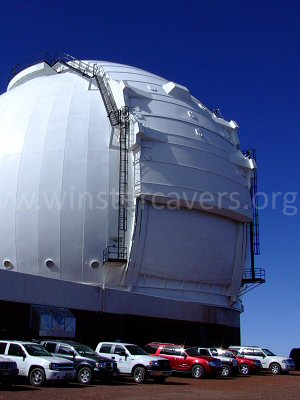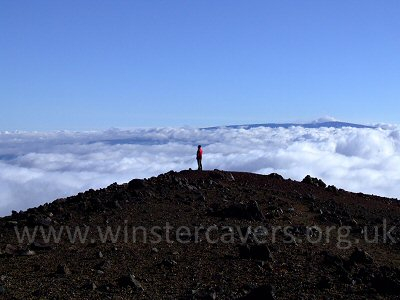A 4x4 drive (or a serious hike)
Grade: |
Drive |
Distance: |
n/a |
Altitude Gained: |
n/a |
Duration: |
n/a |
Given that this site is predominantly based on outdoor adventure, it is with some
hesitation that we publish a day out that was done almost entirely by 4 wheel drive.
And nor do I find it easy to condone putting a road all the way to the summit of
such a beautiful mountain, let alone actually using it!
But the summit of Mauna Kea has such an intriguing balance of traditional culture
mixed with super-high-tech modern world, it's a must for any visitor to the Big
Island of Hawaii.
Right: One of the twin telescopes of the William Keck Observatory, Mauna Kea, September 2008
© Mat & Niki Adlam-Stiles, 2008
|

|
Visit in brief:
Mauna Kea is the tallest mountain on Big Island, quite literally a few feet taller
than Mauna Loa, it stands just short of 4200m high. Many then go on to tell
you how it's actually the largest mountain in the world because of the considerable
depth of it's base below the ocean floor. Sorry guys, but surely you measure
the height of mountains from sea level?!
Mauna Kea is a sacred place in Hawaiian tradition, the highest place on the island
and so, naturally, the place where traditional Hawaiians can get closest to their
gods. High above the cloudline, free from turbulance and light pollution, it's
also an ideal place to pop some of the most sophisticated telescopes in the world.
Visible from the coast, some would argue that these enormous peepers are a scar
on the landscape, whereas others will marvel at the spectacle.
Handling the Altitude:
The warnings about altitude mentioned for the Mauna Loa walk are all relevant, execpt
that as one is driving up, there's less time to acclimatise!
At 9200 feet of altitude there's the Mauna Kea Visitor Centre - spend an hour or
two there to acclimatise, and you should get to the top without too much trouble.
The approach from Hilo (or Kona):
From whichever side of the island you're starting from, you need to get yourself onto highway 200
- the infamous "Saddle Road". The tales of this being a crazy
road only fit for 4x4 vehicles seems to be somewhat out of date - from the Hilo
side at least, the character has been stripped from the road, and replaced with
serious amount of silky-smooth tarmac. The car hire companies may insist you need
a 4x4, but that would appear to just be a useful way of pulling in a few extra dollars!
At the saddle, approximately 1/2 way along the saddle road, you'll find a crossroads.
The newly made-up road to the North takes you up to the summit of Mauna Kea.
Despite what the
car hire firms may tell you, progressing to the visitor centre
in normal weather conditions does not require four wheel drive
- it's a perfectly sound tarmac road.
|
|
Mauna Kea Summit:
|
From the visitor centre, a good 4x4 track winds its way all the way to the summit.
You don't have to be a seasoned off-roader to handle it, but do take it steady as
you gain altitude at an astonishing rate. The other surprise was how much
fuel we used - make sure you've got 1/2 a tank or more left when you set out from
the visitor centre.
If you time it right (Saturday late lunch is a good bet) you can get yourself on
a free guided tour to the top. This starts with a 1 hour acclimatisation at
the visitor centre, including an interesting and balanced video presentation about
the mountain. Hop in a 4x4, and journey to the top in convoy - sort of fun
actually - and if you're really lucky, you'll get a peep inside one of the observatories.
The Hilo University observatory is sometimes open mid-week, we almost got a look
inside the Willam Keck Observatory.
|

High above the clouds at the summit of Mauna Kea, Hawaii.
© Mat & Niki Adlam-Stiles, 2008
|
At the top, it's worth walking out to the true summit, and circumnavigating one
of more of the top craters. The aspect is stunning.
Just before dusk, expect to be joined by a few mini-buses, jam-packed with tourists,
who have paid a significant number of dollars to see the legendary sunset from Mauna Kea (our trip was free). Set yourself up in a comfy position where you're less likely to have
some ignorant tourist stand in front of you just as you take a photo, relax,
and enjoy the sunset.
(It gets very cold, very quickly at the summit, so be prepared!)
On Saturdays, there's a good chance that after dark there will be a guided tour
of the sky at night down at the visitors centre. On our visit they had a number
of telescopes set up, and a very knowledgeable guide.
Suggested Walks on Mauna Kea:
If you have the time, there are a few very appealing looking trails on Mauna Kea,
some of which can be made more accessible by starting form the Mauna Kea Visitor
Centre. For example, a 3500' ascent on the Mauna Kea - Humu ' Ula Trail will
take you to the perpetual Lake Waiau - starting out at the visitor centre and taking
the trail that climbs up from almost opposite the centre.